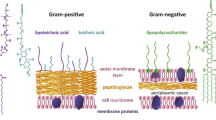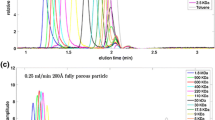Summary
The anion transport protein of the human erythrocyte membrane, band 3, was solubilized and purified in solutions of the non-ionic detergent Triton X-100. It was incorporated into spherical lipid bilayers by the following procedure: (1) Dry phosphatidylcholine was suspended in the protein solution. Octylglucopyranoside was added until the milky suspension became clear. (2) The sample was dialyzed overnight against detergentfree buffer. (3) Residual Triton X-100 was removed from the opalescent vesicle suspension by sucrose density gradient centrifugation and subsequent dialysis. Sulfate efflux from the vesicles was studied, under exchange conditions, using a filtration method. Three vesicle subpopulations could be distinguished by analyzing the time course of the efflux. One was nearly impermeable to sulfate, and efflux from another was due to leaks. The largest subpopulation, however, showed transport characteristics very similar to those of the anion transport system of the intact erythrocyte membrane: transport numbers (at 30°C) close to 20 sulfate molecules per band 3 and min, an activation energy of approx. 140 kJ/mol, a pH maximum at pH 6.2, saturation of the sulfate flux at sulfate concentrations around 100mm, inhibition of the flux by H2DIDS and flufenamate (approx.K l-values at 30°C: 0.1 and 0.7 μm, respectively), and “right-side-out” orientation of the transport protein (as judged from the inhibition of sulfate efflux by up to 98% by externally added H2DIDS). Thus, the system represents, for the first time, a reconstitution of all the major properties of the sulfate transport across the erythrocyte membrane.
Similar content being viewed by others
References
Bachmann, L., Schmitt-Fumian, W.W. 1973. Spray-freezing and freeze-etching.In: Freeze-Etching, Techniques and Applications. E.L. Benedetti and P. Favard, editors. pp. 73–99. Soc. Franc. Microscopie Electronique, Paris
Bartlett, G.R. 1959. Phosphorus assay in column chromatography.J. Biol. Chem. 234:466–468
Barzilay, M., Cabantchik, Z.I. 1979. Anion transport in red blood cells: II. Kinetics of reversible inhibition by nitroaromatic sulfonic acids.Membr. Biochem. 2:255–281
Cabantchik, Z.I., Knauf, P., Rothstein, A. 1978. The anion transport system of the red blood cell. The role of membrane protein evaluated by the use of “probes.”Biochim. Biophys. Acta 515:239–302
Cabantchik, Z.I., Loyter, A. 1980. Functional characterization of isolated membrane transport systems. The erythrocyte anion transporter as a model.In: Membrane Transport in Erythrocytes. U.V. Lassen, H.H. Ussing, and J.O. Wieth, editors. pp. 373–383. Munksgaard, Copenhagen
Cabantchik, Z.I., Volsky, D.J., Ginsburg, H., Loyter, A. 1980. Reconstitution of the erythrocyte anion transport system:In vitro andin vivo approaches.Ann. N.Y. Acad. Sci. 341:444–454
Cousin, J.-L., Motais, R. 1979. Inhibition of anion permeability by amphiphilic compounds in human red cell: Evidence for an interaction of niflumic acid with the band 3 protein.J. Membrane Biol. 46:125–153
Cousin, J.-L., Motais, R. 1982. Inhibition of anion transport in the red blood cell by anionic amphiphilic compounds: I. Determination of the flufenamate-binding site by proteolytic dissection of the band 3 protein.Biochim. Biophys. Acta 687:147–155
Darmon, A., Bar-Noy, S., Ginsburg, H., Cabantchik, Z.I. 1985. Oriented reconstitution of red cell membrane proteins and assessment of their transmembrane disposition by immunoquenching of fluorescence.Biochim. Biophys. Acta 817:238–248
Darmon, A., Zangrill, M., Cabantchik, Z.I. 1983. New approaches for the reconstitution and functional assay of membrane transport proteins. Application to the anion transporter of human erythrocytes.Biochim. Biophys. Acta 727:77–88
Dorst, H.-J., Schubert, D. 1979. Self-association of band 3 protein from human erythrocyte membranes in aqueous solutions.Hoppe-Seyler's Z. Physiol. Chem. 360:1605–1618
Fairbanks, G., Steck, T.L., Wallach, D.F.H. 1971. Electrophoretic analysis of the major peptides of the human erythrocyte membrane.Biochemistry 10:2606–2617
Fraley, R., Wilschut, J., Düzgünes, N., Smith, C., Papahadjopoulos, D. 1980. Studies on the mechanism of membrane fusion: Role of phosphate in promoting calcium induced fusion of phospholipid vesicles.Biochemistry 19:6021–6029
Gerritsen, W.J., Verkley, A.J., Zwaal, R.F.A., Van Deenen, L.L.M. 1978. Freeze-fracture appearance and disposition of band 3 protein from the human erythrocyte membrane in lipid vesicles.Eur. J. Biochem. 85:255–261
Jennings, M.L. 1984. Oligomeric structure and the anion transport function of human erythrocyte band 3 protein.J. Membrane Biol. 80:105–117
Kampmann, L., Lepke, S., Fasold, H., Fritsch, G., Passow, H. 1982. The kinetics of intramolecular cross-linking of the band 3 protein in the red blood cell membrane by 4,4′-diisothiocyanodihydrostilbene-2,2′-disulfonic acid (H2DIDS).J. Membrane Biol. 70:199–216
Knauf, P.A. 1979. Erythrocyte anion exchange and the band 3 protein: Transport kinetics and molecular structure. Curr.Topics Membr. Transp. 12:249–363
Köhne, W. 1982. Rekonstitution des Anionentransportsystems der Erythrotyten-Membran durch Einbau des Transportproteins in Lipid-Vesikel. Allgemeine Eigenschaften und Lipidabhängigkeit des rekonstituierten Systems. Ph.D. Thesis. RWTH, Aachen
Köhne, W., Deuticke, B., Haest, C.W.M. 1983. Phospholipid dependence of the anion transport system of the human erythrocyte membrane. Studies on reconstituted band 3/lipid vesicles.Biochim. Biophys. Acta 730:139–150
Köhne, W., Haest, C.W.M., Deuticke, B. 1981. Mediated transport of anions in band 3-phospholipid vesicles.Biochim. Biophys. Acta 664:108–120
Lukacovic, M.F., Feinstein, M.B., Sha'afi, R.J., Perrie, S. 1981. Purification of stabilized band 3 protein of the human erythrocyte membrane and its reconstitution into liposomes.Biochemistry 20:3145–3151
Lukacovic, M.F., Toon, M.R., Solomon, A.K. 1984. Site of red cell cation leak induced by mercurial sulfhydryl reagents.Biochim. Biophys. Acta 772:313–320
Macara, J.G., Cantley, L.C. 1983. The structure and function of band 3.In: Cell Membranes. Methods and Reviews. E. Elson, W. Frazier, and L. Glasier, editors. Vol. 1, pp. 41–87. Plenum, New York
Pappert, G., Schubert, D. 1983. The state of association of band 3 protein of the human erythrocyte membrane in solutions of nonionic detergents.Biochim. Biophys. Acta 730:32–40
Passow, H. 1986. Molecular aspects of the band 3 proteinmediated anion transport across the red blood cell membrane.Rev. Physiol. Biochem. Pharmacol. 103:61–203
Ross, A.H., McConnell, H.M. 1977. Reconstitution of band 3, the erythrocyte anion exchange protein.Biochem. Biophys. Res. Commun. 74:1318–1325
Ross, A.H., McConnell, H.M. 1978. Reconstitution of the erythrocyte anion channel.J. Biol. Chem. 253:4777–4782
Rothstein, A., Cabantchik, Z.I., Balshin, M., Juliano, R. 1975. Enhancement of anion permeability in lecithin vesicles by hydrophobic proteins extracted from red blood cell membranes.Biochem. Biophys. Res. Commun. 64:144–150
Scheuring, U., Kollewe, K., Schubert, D. 1984. A new method for the reconstitution of the anion transport system of the human erythrocyte membrane.Hoppe-Seyler's Z. Physiol. Chem. 365:1056–1057
Schnell, K.F. 1972. On the mechanism of inhibition of the sulfate transfer across the human erythrocyte membrane.Biochim. Biophys. Acta 282:265–276
Schnell, K.F., Gerhardt, S., Schöppe-Fredenburg, A. 1977. Kinetic characteristics of the sulfate self-exchange in human red blood cells and red blood cell ghosts.J. Membrane Biol. 30:319–350
Schubert, D., Boss, K., Dorst, H.-J., Flossdorf, J., Pappert, G. 1983. The nature of the stable noncovalent dimers of band 3 protein from erythrocyte membranes in solutions of Triton X-100.FEBS Lett. 163:81–84
Schwoch, G., Rudloff, V., Wood-Guth, I., Passow, H. 1974. Effect of temperature on sulfate movements across chemically or enzymatically modified membranes of human red blood cells.Biochim. Biophys. Acta 339:126–138
Tanford, C., Reynolds, J.A. 1976. Characterization of membrane proteins in detergent solutions.Biochim. Biophys. Acta 457:133–170
Ueno, M., Tanford, C., Reynolds, J.A. 1984. Phospholipid vesicle formation using nonionic detergents with low monomer solubility. Kinetic factors determine vesicle size and permeability.Biochemistry 23:3070–3076
Van Hoogevest, P., Du Maine, A.P.M., De Kruijff, B., De Gier, J. 1984. The influence of lipid composition on the barrier properties of band 3-containing lipid vesicles.Biochim. Biophys. Acta 777:241–252
Van Hoogevest, P., Van Duijn, G., Batenburg, A.M., De Kruijff, B., De Gier, J. 1983. The anion permeability of vesicles reconstituted with intrinsic proteins from the human erythrocyte membrane.Biochim. Biophys. Acta 734:1–17
Wolosin, J.M. 1980. A procedure for membrane-protein reconstitution and the functional reconstitution of the anion transport system of the human erythrocyte membrane.Biochem. J. 189:35–44
Yu, J., Steck, T.L. 1975. Isolation and characterization of band 3, the predominant polypeptide of the human erythrocyte membrane.J. Biol. Chem. 250:9170–9175
Author information
Authors and Affiliations
Rights and permissions
About this article
Cite this article
Scheuring, U., Kollewe, K., Haase, W. et al. A new method for the reconstitution of the anion transport system of the human erythrocyte membrane. J. Membrain Biol. 90, 123–135 (1986). https://doi.org/10.1007/BF01869930
Received:
Revised:
Issue Date:
DOI: https://doi.org/10.1007/BF01869930




